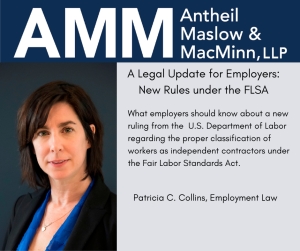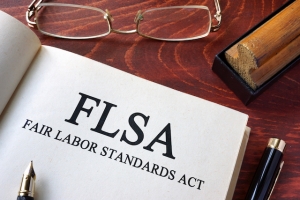The Department of Labor's New Independent Contractor Rule
Reprinted with permission from the February June 13th edition of The Legal Intelligencer. (c) 2024 ALM Media Properties. Further duplication without permission is prohibited.
On January 9, 2023, the United States Department of Labor issued a new final rule regarding the proper classification of workers as independent contractors under the Fair Labor Standards Act. While the rule is technically new, it is, in substance, a recitation of the applicable law regarding the proper classification of workers set forth by the Supreme Court.
Prior to recent rule making, caselaw guided the determination of whether a worker was an employee or independent contractor under the Fair Labor Standards Act (“FLSA”). In United States v. Silk, the United States Supreme Court outlined the factors relevant to the determination: degree of control, opportunities for profit or loss, investment in facilities, permanency of relations and skill required in the claimed independent operation. The Silk court noted that “no one factor is controlling.” Just about every court, federal or state, applies the same or similar standard to determine the issue under the FLSA or state statutes regarding minimum wage and overtime pay.
The Ninth Circuit Permits a Title VII Claim Based On Offensive Music in the Work Place
Reprinted from the April 20th edition of The Legal Intelligencer. (c) 2023 ALM Media Properties. Further duplication without permission is prohibited.
In Sharp v. S&S Activewear, LLC, the United States Court of Appeals for the Ninth Circuit tackled the difficult issue of when a generally toxic workplace becomes a hostile environment under Title VII. 42 U.S.C. § 2000e-2(a)(1). The Ninth Circuit’s conclusion that employees’ allegations regarding playing offensive music in the workplace were sufficient to state a claim for a hostile work environment under Title VII relied on recent Supreme Court precedent, in Bostock v. Clayton County, 140 S. Ct. 1731 (2020); and Oncale v. Sundowner Offshore Servs, 523 U.S. 75 (1998).
The Trafficking Victims Protection Act and Liquidated Damages Provisions in Employment Agreements
Reprinted with permission from the October 14th edition of The Legal Intelligencer. (c) 2022 ALM Media Properties. Further duplication without permission is prohibited.
Employers eager to recapture the costs of hiring foreign citizens often use damages or repayment provisions in employment agreements. A recent case in the Southern District of New York illustrates a challenge to that strategy. The Southern District’s recent decision in Baldia v. RN Express Staffing Registry LLC to allow a complaint under the federal Trafficking Victims Protection Act (“TVPA”) to proceed, is part of a growing trend in using the TVPA to challenge such agreements.
The plaintiff in the Baldia case, Marie Alexandrine Baldia, is a citizen of the Philippines. RN Express Staffing recruited her from the Philippines and hired her as a registered nurse supervisor after sponsoring her visa to work in the United States. Baldia signed an Employment Agreement for a three-year term, that included a liquidated damages provision. Specifically, the Employment Agreement required that in the event Baldia left the employ of RN Express Staffing, “without cause”, before the end of the three-year term, she would need to repay the costs of “recruiting, training and placement”. The Employment Agreement recited that the “Company Recruitment Costs” totaled $33,320, and that the number would be reduced after her first full year of employment.
Attention Employers: New Department of Labor Ruling on Overtime Pay
On September 24, 2019, the United States Department of Labor announced a new final rule regarding eligibility for overtime pay. The rule requires employers to revisit their classifications of employees as exempt in order to ensure compliance.
As I discussed in previous articles (Texas Federal Judge Blocks New Overtime Rules and Speaking of Overtime Rules and One Final Overtime Update) the DOL announced rules in 2016 to dramatically increase the salary threshold in order for certain categories of employees to meet the standards for exemption from federal overtime requirements. The rules were met with litigation and a stay of their enforcement.
The new final rule raises the salary threshold from $455 a week to $684 a week, or $35,568 a year. Employers may now use nondiscretionary bonuses and incentive payments, such as commissions to satisfy up to 10% of the salary level. Employees will still have to meet requirements related to their duties in order to meet the standards of exemption for the overtime requirements.
This final rule will become effective on January 1, 2020. As we advised in 2016, employers should take steps to ensure compliance by the end of the year. The first step is to identify any employees who are classified as exempt but are making less than $422 a week, and develop a plan to reclassify those employees, or revise their compensation. This is a good time to revisit the job duties of those employees to ensure that they meet the applicable standards for exemption in terms of their duties as well as their salary. This is also a good time to review overtime policies to ensure appropriate recordkeeping, efficient use of overtime and compliance with applicable law.
AMM can help employers navigate these new rules and review their employee classifications to ensure compliance and minimize risk.
THE SIDE GIG AND THE FLSA: THE SIXTH CIRCUIT KEEPS UP WITH MODERN ECONOMIC REALITIES
A recent case from the United States Court of Appeals for the Sixth Circuit demonstrates the ongoing struggle to apply the Fair Labor Standards Act (“FLSA”) to the “side gigs” that have come to signify the modern employment market. In Acosta v. Off Duty Police Services, Inc., United States Court of Appeals for the Sixth Circuit, Nos. 17-5995/6071 (February 12, 2019), the Sixth Circuit held that security offers working for Off Duty Police Services (“ODPS”) as a side job were employees entitled to overtime pay under the FLSA.
ODPS workers were either sworn law enforcement officers who worked for law enforcement entities during the day, or unsworn workers with no background in law enforcement. All workers had the same duties, but sworn officers earned a higher hourly rate. Duties included “sitting in a car with the lights flashing or directing traffic around a construction zone.” They were free to accept or reject assignments, but would be punished by withholding future assignments if they did so. When they accepted an assignment, ODPS instructed the workers where to report, when to show up, and who to report to upon arrival. ODPS provided some equipment, but workers did have to use some of their own equipment. Workers followed customer instructions while on assignment, and only occasionally received supervision from ODPS. ODPS paid workers for their hours upon submission of an invoice. Workers did not have specialized skills, as sworn officers and unsworn workers had the same duties.
ODPS treated the workers as “independent contractors.” As the facts set forth in the Sixth Circuit opinion demonstrate, the factors relevant to determining whether a worker is an independent contractor or employee do not provide a clear answer. The United States District Court for the Western District of Kentucky broke the tie this way: the court held that “nonsworn workers” were employees, but that the sworn officers were independent contractors because they “were not economically dependent on ODPS and instead used ODPS to supplement their incomes.”
The Sixth Circuit disagreed, noting that the FLSA is a broadly remedial and humanitarian statute, designed to improve labor conditions. The Sixth Circuit applied the “economic reality” test to determine that the sworn offers were also employees and not independent contractors, and to uphold the finding that unsworn workers were employees. Specifically, the Court noted that the officers provided services that represented an integral part of the business, and that the work required no specialized skills, that the officers made only limited investment in equipment, and that the workers had little opportunity for profit or loss. The Court noted that the facts did not “break cleanly in favor of employee or independent contractor status” regarding the right to control the work for the sworn officers.
Navigating Noncompetes Part III: Employees, the Restricted Parties
In the last segment of this series, we focused on concerns for employers in drafting and enforcing restrictive covenants. The choices for employees are fewer, and none of them are good. Employees are generally asked to sign restrictive covenants at two points: either at the beginning of their career or upon a promotion or other significant improvement in employment status. Such agreements diminish employees’ choices should they want to move on from their current employment, whether or not the restrictions are actually enforceable.
Some employers require employees to sign a restrictive covenant at the outset of their employment. If the employee was recruited and has other employment choices, the employee has some bargaining power to reduce the duration or scope of the restrictions. But this is seldom the case, and the law recognizes that employees generally have limited (or no) bargaining power in these situations. The law disfavors restrictive covenants for precisely this reason: the agreement imposes a post-employment restriction that may hinder the employee’s ability to earn a living at a time when the employee has little or no bargaining power to negotiate the restriction.
This calculus changes a little when the employee is required to sign a restrictive covenant in conjunction with a promotion or other benefit, such as participation in a stock option or bonus program. Then the employee has to decide whether the value of the promotion or other benefit is enough to justify agreeing to the post-employment restriction. Where it is not, the employee can refuse to sign, forcing the employer to decide how valuable this employee is to the employer. However, the employee should factor into this decision that the employer is free to terminate the employee for refusing to sign. And, this might be a good thing, as the employee will be leaving the employer without a noncompete.
Frequently, employees breach the restriction without consulting an attorney first based on the widely held, mistaken, belief that courts do not enforce noncompetes. Let’s be clear: courts will enforce noncompetes where the law permits them to do so. More importantly, the old employer will sue the employee and the employee’s new employer for breach of the agreement. The new employer may terminate the new employment to avoid the costs of litigation. Litigation regarding these matters is expensive, time-consuming and stressful. Practically speaking, most employers will refuse to hire an employee with a restrictive covenant even if it is unenforceable for any number of technical reasons we have discussed in this series.
At the very least, employees should consult an attorney prior to signing, even if they have limited bargaining power, to understand the restrictions in place. We can help employees with that review, and we can help employees navigate the minefield of finding new employment when they have a noncompete in place.
Navigating Noncompetes Part II: What Employers Should Consider
Part 2 of our Noncompete Series will focus on employers. Noncompetes, when well drafted, are a powerful tool to protect customer relationships, confidential information, trade and training secrets, and key employee relationships. But, the law does not favor these agreements, so drafting requires care, and, as a practical matter, timing is everything.
While noncompetes are disfavored and maligned, they do serve useful purposes for certain employers. There are two types of restrictions that such agreements can impose: general prohibits on certain kinds of competition; or, prohibitions on soliciting customers, vendors, employees, contractors, or other valuable relationships. For the most part, restrictions on soliciting customers, employees and other key relationships are easier to enforce. They allow the employee to continue to work, and protect those relationships for the employer. For some employers, these restrictions, tailored to their business and in place for a sufficient period of time, are enough. Generally, these restrictions tend to last a year or perhaps two. Employers will need to weigh the dangers of making the restriction too long, and thus unenforceable, as against the time it takes for those relationships to go stale.
Restrictions on competition generally are another matter. The general principle applied by the court is this: a court will not enforce the restriction if it is not designed to protect a legally recognized protectable interest, renders an employee unable to pursue his chosen profession, or appears designed to eliminate fair competition. The court will only act to protect the following interests: trade secrets or confidential information, specialized training the employee received from the employer, or customer good will developed using the employer’s resources. Given these competing factors, it is best to narrowly tailor the restriction to the employer’s business. An employee is more likely to comply with such a restriction (thus avoiding court), and a court is more likely to enforce it as written.
Employers next must consider when to ask employees to sign noncompetes. These agreements are enforceable when signed at the beginning of the employment relationship. A noncompete executed by an employee after the employee has worked for the employer for a period of time is not enforceable unless accompanied by a raise or promotion, or some other benefit. This creates a practice problem for employers. Often, a noncompete is not required at the beginning of employment, but circumstances change: employees are promoted, the nature of the business changes, the employer becomes more sophisticated about its internal procedures, for example. A skilled employee with options in the marketplace may very well refuse to sign such a restriction where the new consideration offered is simply not worth it. So, for example, while a bonus of $500 is enough to make the agreement legally enforceable, it may also not be enough to cause the employee to sign. This creates a difficult situation for the employer – should the employer terminate and lose the key employee, or allow the employee to stay without a noncompete?
Creating a noncompete program for employees is complex, and many of the issue are interrelated. In addition to the legal concerns, employers must consider what concerns and relationships truly require protection, as well as retention and morale issues. We have helped many employers sort through these issues and are uniquely equipped to help businesses navigate difficult noncompete issues.
The third installment of my Navigating Noncompetes series will look at noncompetes from the employee's perspective, outlining potential issues which should be considered before signing such an agreement.
Patty Collins Participates in Panel on New DOL Overtime Regulations
Patty Collins, a Partner with Antheil, Maslow & MacMinn, will be joined by Cindy Bergvall, CPA, of Bee, Bergvall & Co. for a panel discussion on new Department of Labor overtime regulations and their impact on employers. This informative breakfast seminar is hosted by The Catalyst Center for Nonprofit Management on October 7th at Aldie Mansion in Doylestown. There is no charge for this event, but registration is required.
These new regulations will require action from almost every for-profit and not-for-profit organization with employees earning less than $47, 476 per year. Participants will learn about the changes in the law and what organizations will need to do when the law goes into effect on December 1, 2016.
Unemployment Compensation Hearings: Sometimes You Get a Do-Over
By Patricia C. Collins, Esquire, Reprinted with permission from the March 23, 2015 issue of The Legal Intelligencer. (c) 2015 ALM Media Properties. Further duplication without permission is prohibited.
Recently, the United States District Court for the Eastern District of Pennsylvania, in Mathis v. Christian Heating and Air Conditioning, Inc., 13-3747 (March 12, 2015), examined the effect of factual findings in unemployment compensation proceedings in Pennsylvania on discrimination claims filed in federal court. The conclusion? The discrimination case is a “do over,” and nothing determined by the tribunal (including the Unemployment Compensation Board of Review and the Commonwealth Court) will collaterally estop either party, presumably, from taking a contrary position in the subsequent wrongful termination suit.
The facts are these: Mr. Mathis was employed at Christian Heating and Air Conditioning (“Christian Heating”) for nearly two years. During that time, Mr. Mathis had placed black tape over part of his identification badge. The objectionable part of the card professed the company’s mission statement to, inter alia, run the business in a way that was “pleasing to the lord [sic]….” Mr. Mathis’s supervisor and the owner of the business required him to remove the tape from the back of his badge. Mr. Mathis refused to do so, and contended that he was terminated as a result.








